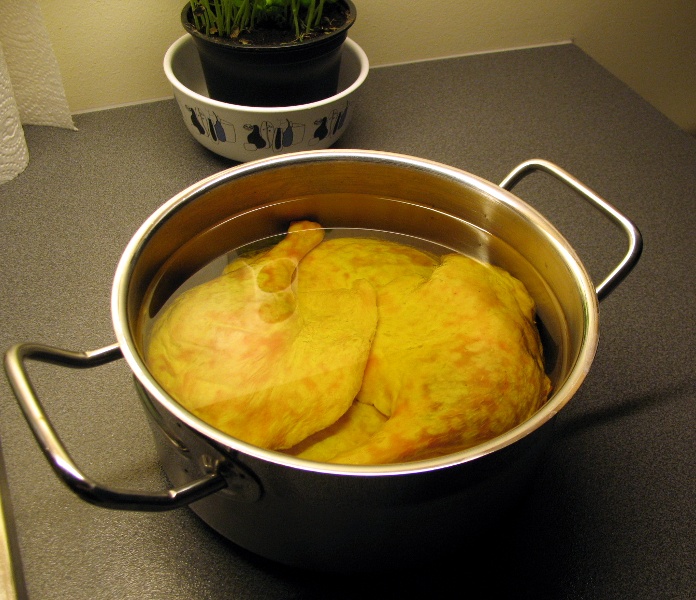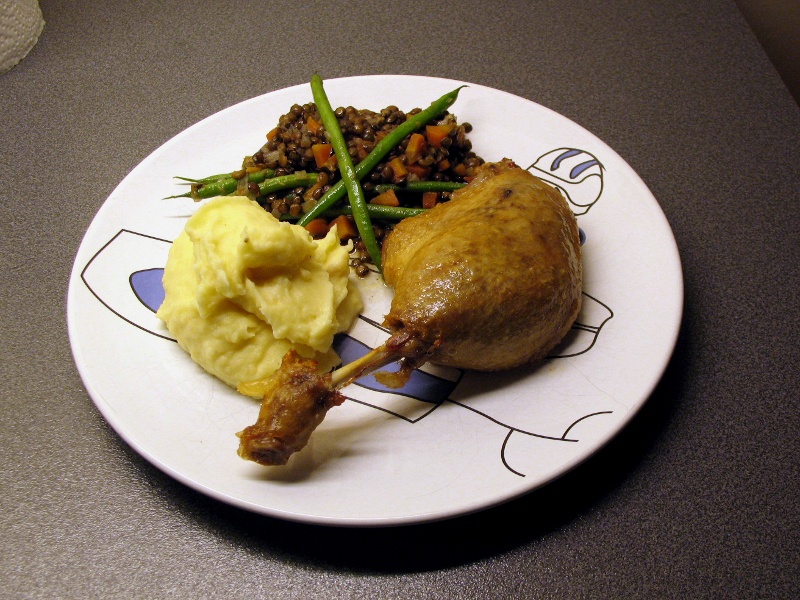I admit there's not a speck of either lactobacilli or saccharomyces cerevisiae on the ingredient list this time, but that doesn't mean it's no good... I've been busy in the kitchen (breadwise and otherwise) the last few weeks, but my blog's been sadly neglected. This weekend's dinner is something that really looks after itself once you've popped it into the oven, so I thought I could use the opportunity to snap a few photos.
Ever since I bought Ruhlman and Polcyn's book on charcuterie, I've wanted to try the confit method of cooking and preserving meat. Back in the day, after harvesting foie gras, French farmers of Gascony and the Dordogne had great quantities of duck meat and duck fat, but no easy way to conserve the meat, save for the confit technique. Today, with refrigeration, the main reason for using confit is the unique tenderness, texture and flavour of confited meat that make the technique worthwhile.
In brief, the meat is first dry cured with salt (add pepper, coarsely ground cloves and a clove of garlic if you like) for 24 hours. Rinse off all excess salt under cold, running water and place the meat in an ovenproof pot or casserole. Pour over rendered fat (or oil) so that all the meat is covered and place in a low oven for 8 - 12 hours, until the meat is beautifully tender and settled on the bottom of the baking vessel. Keep the meat submerged in the fat and cool to room temperature before covering the vessel with foil and refrigerating it. Both Ruhlman/Polcyn and Robuchon have great recipes for duck confit, that, if followed accurately, produce confits that can be kept for up to 6 months in the refrigerator. As the fat turns solid, and prevents air to reach the meat, the confit technique is a way of hermetically sealing meat.
I had problems obtaining duck fat, so I used a cheap olive oil as the poaching medium instead. The olive oil doesn't turn solid in the refrigerator, so this will not make a fully conserved duck confit. According to Ruhlman, it can still be kept for up to a month in the fridge, but mine won't last that long. Promise.
So... Rub your duck legs with generous amounts of coarse sea salt, a few ground cloves, pepper corns and a crushed clove of garlic. Place in the fridge for 24 hours, then rinse and place in a tight cooking vessel. The tighter you can place the meat in the vessel, the less fat/oil you need to use to cover the meat:

Fill it up all the way so that all meat is covered in rendered fat/oil:

Now, a good idea is to first warm the pot over medium-high heat until the oil is close to the simmering temperature of water. This will give the legs a good thermal kick in the beginning (otherwise you might have to extend the baking time in the oven by several hours). Then place in a low (approx 80 - 85 dC) oven, uncovered, until the meat is absolutely tender. One way to check whether it's finished, is to gently pierce the meat with a skewer. If the fat that runs out is a thin, liquid stream, it's done. My four legs were done in roughly 8 hours. Remove from oven and let the vessel come to room temperature before you cover it with foil and refrigerate it.
A simple but tasteful dish of confited duck legs can be made by cooking the legs at 220dC for 15 mins (the last few minutes with the broiler on to make a ridiculously crisp and delicious skin) and serving them with a ragu of lentils (I used green du Berry lentils), carrots, shallots, garlic, asparagus beans and a potato purée. Shredded duck confit is amazing in salads as well. Oh, and did I mention that this is great with bread too? A tasty duck rillette on freshly baked pain au levain... sacrebleu. Bon appétit!
